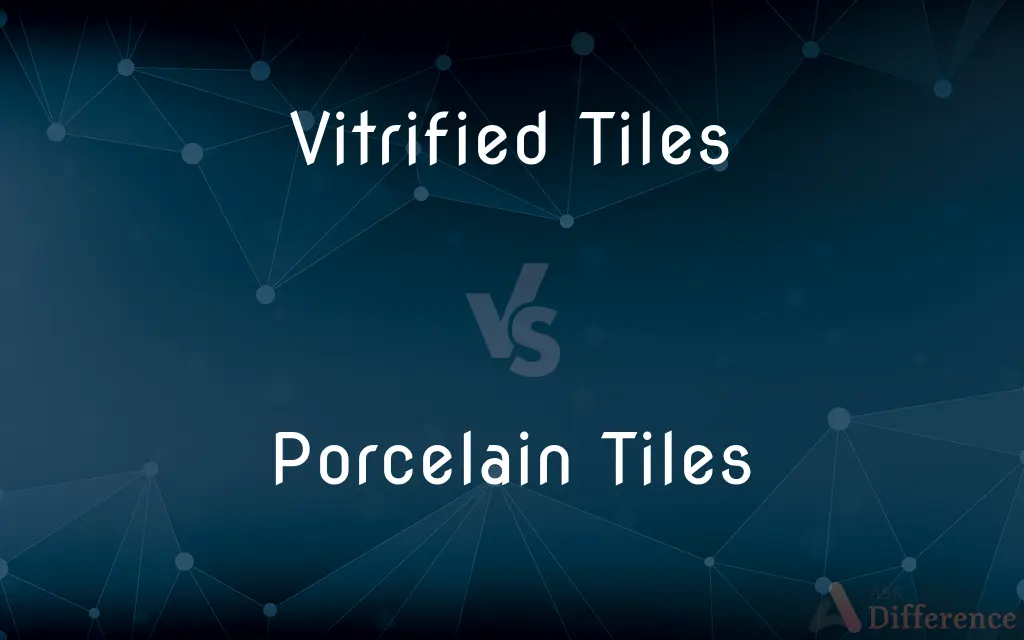Vitrified Tiles vs. Porcelain Tiles — What's the Difference?
By Tayyaba Rehman — Published on November 26, 2023
Vitrified Tiles are ceramic tiles with low porosity, while Porcelain Tiles are typically denser and might have through-body color.

Difference Between Vitrified Tiles and Porcelain Tiles
Table of Contents
ADVERTISEMENT
Key Differences
Vitrified Tiles, widely recognized for their capacity to absorb minimal water, are manufactured through a process that vitrifies (turns into glass) the clay. In contrast, Porcelain Tiles, while also exhibiting low water absorption, tend to boast of their refined quality and often present through-body color, meaning the color persists from surface to bottom.
Porcelain Tiles are frequently lauded for their durability and strength owing to their manufacturing process, which involves being fired at higher temperatures compared to other tiles. Vitrified Tiles, on the flip side, though also durable, might not boast the same level of hardness and strength as Porcelain Tiles, yet they offer an impressive resistance to stains and water, which can be a pivotal factor in tile selection.
Vitrified Tiles tend to be available in a variety of designs, colors, and prints, often providing a wider array of aesthetic choices for interior and exterior applications. Alternatively, Porcelain Tiles may offer a more restricted variety in terms of print and design but compensate by offering a generally superior quality in terms of strength and wear resistance.
Vitrified Tiles might sometimes offer a more cost-effective solution for flooring and wall applications, making them an attractive option for budget-conscious projects. Whereas Porcelain Tiles might come with a heftier price tag due to their renowned durability and the higher-quality clay used, justified by their longevity and wear resistance.
Vitrified Tiles and Porcelain Tiles, despite their individual characteristics, can often intersect in applications, with the choice often boiling down to specific project requirements and aesthetic preferences. While Vitrified Tiles might be preferred for their design versatility and generally lower cost, Porcelain Tiles might be chosen for areas demanding high durability and specific aesthetic qualities.
ADVERTISEMENT
Comparison Chart
Water Absorption
Low
Very low
Cost
Generally more affordable
Tend to be more expensive
Design Versatility
Available in various designs and prints
May have through-body color, less print variety
Durability
Durable but may be less than porcelain
Extremely durable
Manufacturing Process
Vitrification of clay
Fired at higher temperatures
Compare with Definitions
Vitrified Tiles
Vitrified Tiles can be applied in various settings.
She chose Vitrified Tiles for both indoor and outdoor flooring.
Porcelain Tiles
Porcelain Tiles can be used in high-traffic areas.
The designer recommended Porcelain Tiles for the busy commercial space.
Vitrified Tiles
Vitrified Tiles often feature diverse designs.
Vitrified Tiles adorned the bathroom in an array of patterns.
Porcelain Tiles
Porcelain Tiles are made from refined clay.
Porcelain Tiles in the kitchen showcased a high-quality finish.
Vitrified Tiles
Vitrified Tiles undergo a process of vitrification.
The Vitrified Tiles retained low moisture due to vitrification.
Porcelain Tiles
Porcelain Tiles are typically low in porosity.
The Porcelain Tiles in the bathroom resisted water effectively.
Vitrified Tiles
Vitrified Tiles are recognized for stain resistance.
The Vitrified Tiles in the lobby maintained their appearance despite heavy foot traffic.
Porcelain Tiles
Porcelain Tiles often possess through-body color.
Scratches were less noticeable on the Porcelain Tiles due to their consistent color throughout.
Vitrified Tiles
Vitrified Tiles are low-porosity ceramic tiles.
The Vitrified Tiles in the kitchen were stain-resistant.
Porcelain Tiles
Porcelain Tiles are known for their durability.
The Porcelain Tiles in the hallway lasted for decades.
Common Curiosities
What are Vitrified Tiles?
Vitrified Tiles are ceramic tiles known for their low porosity and stain resistance.
Are Vitrified Tiles suitable for outdoor use?
Yes, Vitrified Tiles can be used outdoors due to their low water absorption.
Can Vitrified Tiles be used in kitchens?
Yes, Vitrified Tiles can be used in kitchens and are often chosen for their stain resistance.
Do Vitrified Tiles come in various designs?
Yes, Vitrified Tiles are available in a wide array of designs and colors.
Which is more expensive: Vitrified Tiles or Porcelain Tiles?
Typically, Porcelain Tiles tend to be more expensive than Vitrified Tiles.
What kind of maintenance do Vitrified Tiles require?
Vitrified Tiles require minimal maintenance, typically needing regular cleaning with a mild detergent.
Is the color of Porcelain Tiles surface-deep?
No, Porcelain Tiles often have through-body color, maintaining color throughout the tile.
Can Vitrified Tiles resist stains?
Yes, Vitrified Tiles are known to be highly stain-resistant.
How are Porcelain Tiles made?
Porcelain Tiles are made by firing refined clay at high temperatures.
Are Porcelain Tiles suitable for bathrooms?
Yes, Porcelain Tiles are suitable for bathrooms due to their low water absorption.
Are Porcelain Tiles durable?
Yes, Porcelain Tiles are known for their durability and resistance to wear.
Can Porcelain Tiles be used in commercial areas?
Yes, due to their durability, Porcelain Tiles are suitable for commercial use.
How long do Porcelain Tiles last?
With proper care, Porcelain Tiles can last for decades, even in high-traffic areas.
Are Porcelain Tiles heavier than Vitrified Tiles?
Porcelain Tiles might be denser and potentially heavier due to their manufacturing process.
Are Vitrified Tiles slippery?
Vitrified Tiles can be slippery, especially the ones with a glossy finish.
Share Your Discovery

Previous Comparison
Wet Market vs. Dry Market
Next Comparison
Kupffer Cells vs. HepatocytesAuthor Spotlight
Written by
Tayyaba RehmanTayyaba Rehman is a distinguished writer, currently serving as a primary contributor to askdifference.com. As a researcher in semantics and etymology, Tayyaba's passion for the complexity of languages and their distinctions has found a perfect home on the platform. Tayyaba delves into the intricacies of language, distinguishing between commonly confused words and phrases, thereby providing clarity for readers worldwide.
















































